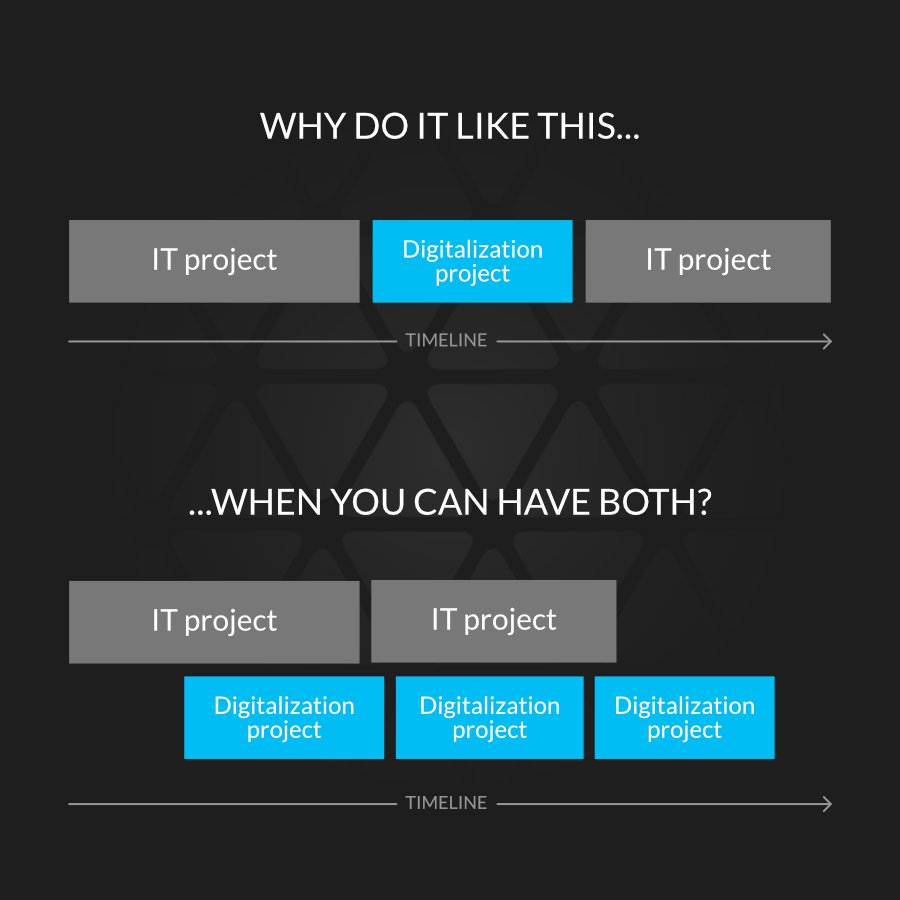
3 things to consider when budgeting for IT & digitalization projects in 2024
Q4 is well on the way, and it’s time to plan and budget for the next year – are you making the most out of your budget for 2024?
Over-relying on ERP systems in 2024 can prove costly
Q4 is well on the way, and it’s time to plan and budget for the next year – are you making the most out of your budget for 2024?
Based on our 20+ years of hands-on experience in business digitalization, we at Bluugo know that you can make or break a project before it has even started – well begun is half done. We thought it’s the perfect time to share some insights to help you choose the best possible tools for your initiatives, avoid some of the common pitfalls, and make the most out of your digitalization & IT budget.
So, here’s our list of 3 things to keep in mind when planning and budgeting your digitalization & IT efforts for 2024
1. The distinction between digitalization and IT
The words “digitalization” and “digital transformation” can be found in the strategy of pretty much every listed company in the world. Everyone wants to go digital, and leverage cutting edge tools and technology to streamline their business – which is great! Meanwhile, 84% of digital transformation initiatives are failing – not so great.
In our experience, the problem is not that companies wouldn’t know what they want. In most digitalization initiatives, the objectives are quite clear and usually revolve around increasing end-to-end visibility, data-driven decision-making, and effective collaboration between stakeholders across the value chain. The real challenge seems to be getting there – turning the initiatives into actual solutions.

There seems to be a massive misalignment between what companies think they are doing and what they are actually doing.
Digitalization and conventional IT projects are two separate things with their distinctive goals, purposes, and best practices.
This simple truth is overlooked by a shocking number of companies and usually leads to a situation where business-driven digitalization initiatives are being blocked by internal IT projects – ERP development being the most common topic. The key to success is understanding you can do both at the same time. Instead of waiting months or years for an ERP project to finish, companies can and should execute business-lead digitalization initiatives simultaneously by introducing more modern tools.
Read more: Business digitalization shouldn’t be an IT project

2. ERP systems are great but not for everything
One of the main reasons for the numerous failed initiatives is the wrong choice of tools for the job. Modern business digitalization revolves strongly around seamless data sharing and collaboration between every stakeholder in your value chain – both internal and external. Still, many companies are trying to build these solutions using conventional IT tools, such as ERP systems, that are mainly built for internal processes. This is a fundamentally flawed approach that can lead to even bigger challenges in the future.
Utilizing ERP systems for modern customer-facing solutions also brings up major security concerns. Granting external stakeholders access to the very heart of your business to share information is always a serious safety hazard.
Read more in our other blog “Focusing on ERP systems in business digitalization can ruin a company”.
3. Modern tools can supercharge your ERP
Even though ERP systems alone do not meet the requirements of modern B2B digitalization, they shouldn’t be ignored either. These systems run in the very heart of the business and play a pivotal role in the IT architecture. The key to success lies in recognizing the areas where the conventional systems meet their limits, and more modern tools are required to fill in the gaps.
“Traditionally, companies have been focused on buying ERP solutions and managing the vendor and the system integrator to do the customizations. While this is still good enough for areas where one relies mostly on standard processes, it is not sufficient for areas where companies require something tailored to their needs.” (The ERP Platform Play, McKinsey 2023. Read the full article here.)
By introducing modern cloud platforms, like Bluugo’s Tracking Cloud®, companies can get the most out of their ERP while simultaneously utilizing more flexible tools to cover the areas where conventional systems meet their limits. For once, you CAN have the cake and eat it too.
Read more about the relationship between ERP systems and Tracking Cloud® here.
Conclusion – don’t let your ERP dictate the next year’s budget
In many companies, ERP systems have been the bedrock and foundation for all IT-related initiatives for decades. They still have an important role to fill and will also in the future. However, the business world has passed the point where the significance of ERP systems is growing – in fact, their role is already starting to decrease in the big picture.
Instead of building new solutions with their ERP systems, companies should start systematically moving functions away from them to guarantee future-proofness and safeguard their competitiveness in the long run. To build beside the ERP – not on top of it.
If your company is planning to execute digitalization initiatives in 2024 and you are pondering the best possible approach to make them happen, we are glad to offer you our 20+ years of hands-on experience and industry knowledge. Let’s set up a meeting to discuss your needs and find the best possible way to achieve your goals – and make the most out of your budget for 2024!
Tracking Cloud® – the hyperadaptive cloud platform
Tracking Cloud® is the world’s first hyperadaptive cloud platform for B2B digitalization.
It provides everything needed for digitalizing core business processes and filling the black holes in your value chain in a truly data-driven and future proof way – with unprecedented ease, speed, and efficiency.
Tracking Cloud® is not restricted to any specific business area, process, or industry. It offers a versatile toolbox of fully customizable features and capabilities that can be used to digitalize essentially any B2B business processes.
The most common use cases revolve around logistics & supply chains, aftermarket services, manufacturing, procurement, and traceability – usually combining elements from multiple business areas in ways that are not supported by conventional IT tools and ERP systems.
